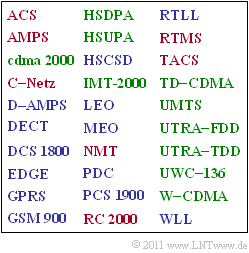Exercise 3.1: Development of the Mobile Network
First mobile communication systems came onto the market in the mid to late 1950s, in Germany for example the "A–Netz".
However, the devices of that time cannot be compared with today's mobile phones in any way, either in terms of performance, volume or even more so in terms of weight.
Since the early 1980s, the development of mobile communications technology has progressed rapidly. Approximately every ten years, there have been significant changes in technology, performance and the services offered.
The fourth generation $\rm LTE$ (Long Term Evolution) of mobile communications was specified in 2008 with UMTS Release 8 and has also been available in Germany since around 2013, although it is not yet available nationwide today (2017).
Notes:
- The task belongs to the chapter History and Development of Mobile Communication Systems.
- In the diagram some terms and abbreviations of mobile radio are shown. There is no direct reference to the task.
- The colors indicate that the systems belong to the first, second and third generation of mobile radio.
Questions
Solution
(1) Correct are the proposals 1 and 4:
- The first generation of mobile communications $\rm (1G)$ offers only analog voice transmission.
- In addition to the systems mentioned above, ACS, NMT, TACS, RTMS and RC2000 are also included in the first generation of mobile communications
(marked in red in the graphic on the data page). - They all came onto the market in the early to mid of the 1980s.
(2) Correct are the proposals 1 to 4:
- The best known $\rm 2G$ representative is GSM, but also the cordless telephony standard DECT and the Japanese PDC belong to the 2G systems
(marked blue in the graphic on the information page). - The last statement is wrong: For example, the German "D–net" (Telekom TD1, Vodafone D2) operates in the frequency range around 900 MHz.
(3) Correct are the statements 1 to 3:
- Shortly after the introduction of GSM in the early 1990s, it became clear that the GSM data rate $(9.6 \ \rm kbit/s)$ was not sufficient for more demanding applications.
- The GSM extensions around the turn of the millennium include HSCSD $($up to $57.6 \ \ \rm kbit/s)$, GPRS $($up to $171 \ \ \rm kbit/s)$ and EDGE $($maximum $384 \ \ \rm kbit/s)$.
- HSDPA and HSUPA, which describe further developments of UMTS with regard to higher data rates in the downlink and uplink, may not be added to GSM phase 2+.
- EDGE may actually be a further development of GSM, but it is nevertheless also listed as a 3G mobile communications system. The data rate is up to $384 \ \rm kbit/s$.
- The first statement is also correct. With the "Phase 2+" the Adaptive Multi–Rate Codec (AMR) was also introduced, resulting in better voice quality.
(4) Correct are the statements 2 and 3:
- OFDM based LTE ("Long Term Evolution") brings further improvements and is also called E–UTRA in the UMTS standard, but it is considered to be of fourth generation $\rm (4G)$.
- All systems of the third mobile radio generation $\rm (3G)$ are marked green in the graphic on the information page.
